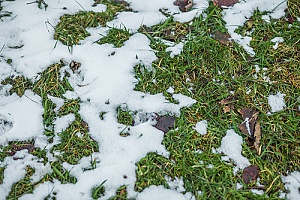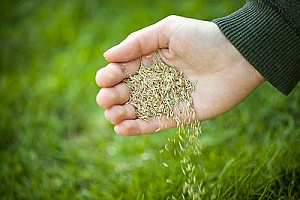 Fall and winter are more important for your lawn than you may realize. It is easy to think of these seasons as the time when you get a break from lawn care, and while that is true to an extent, there are some things you should be doing in these months to ensure a healthy lawn in the spring. Proper lawn care in the winter can provide wonderful benefits for the Spring.
Fall and winter are more important for your lawn than you may realize. It is easy to think of these seasons as the time when you get a break from lawn care, and while that is true to an extent, there are some things you should be doing in these months to ensure a healthy lawn in the spring. Proper lawn care in the winter can provide wonderful benefits for the Spring.
Steps to Protect Grass In Winter
We have created this list of how to protect grass with proper lawn care in the winter. Follow these, and you will be giving your lawn the best chance at making it through the coldest months of the year so it can come back lush and green in the spring.
1. Aerate Your Lawn
Do not forget that your grass needs to breathe, just like you. Over time, soil gets compacted and forms tight plugs that do not allow air or water through. Compacted soil can also make it difficult for grass to expand its root system and for new grass seeds to sprout.
Aerating your lawn breaks up compacted soil and creates small holes in the lawn that let more air and water in. The looser soil created when you aerate also makes it easier for the grass to expand and grow. Aerating tools look similar to pitchforks, and to use them, you simply push the tines into the dirt and twist. Motorized aerating tools also exist; they are similar in size to a lawn mower, and they will make the work much easier.
You should aerate your lawn at least once per year, and fall or early winter is an excellent time to do so. If you know what type of grass your lawn has, you can look up how much aeration is ideal for it. It may need more than one aeration per year.
2. Seed Your Lawn
 Fall and winter are often the best time to plant more grass seed in your lawn. This is the time of year when soil reaches its ideal temperature and grasses put their energy into growing their root systems. Planting grass seed now will guarantee a lush, green lawn in the spring.
Fall and winter are often the best time to plant more grass seed in your lawn. This is the time of year when soil reaches its ideal temperature and grasses put their energy into growing their root systems. Planting grass seed now will guarantee a lush, green lawn in the spring.
Resist the urge to buy the cheapest seed you can find. Cheap seed will include weed seeds and low-quality seed that may not germinate or may simply grow weak grass that will not live long. Spend the extra money to buy high-quality seed that will have high germination rate and good disease and pest resistance. Once you have planted your seeds, water them every day for 10-20 days to ensure that they germinate.
3. Fertilize Your Lawn
Try to fertilize before the first frost hits. This gives your grass the nutrients it needs to survive the harsh, cold months that are coming. The lawns that get a late season fertilization are almost always the first lawns to grow in the spring, because they have been well-fed.
You want to use a fertilizer that has 10-15% phosphorous, because phosphorus is essential to root growth. The roots are the part of the grass that does the most growing over the winter months, so feeding the roots is more important than anything else. Nitrogen-rich fertilizer is a good alternative if phosphorus fertilizers have been banned where you live.
4. Turn Leaves Into Mulch
Before the first frost, you should rake up all the leaves on your lawn. This will minimize brown spots in the grass in the spring and will allow more sunlight to reach the grass. Wet leaves on the ground make it difficult for the grass to breathe and can kill off large patches of grass.
Once you have raked the leaves into a pile, use the mulching blade on your lawnmower to grind the leaves into a fine mulch that you can then spread over the lawn. This mulch will help to protect your grass from the harshest weather, and as it decays, it will release nutrients into the soil that will promote healthy grass in the spring.
5. Keep Mowing
 You want to be sure to keep your grass between two and two-and-a-half inches tall throughout the winter. If the grass gets much taller, it can mat together, which makes it susceptible to mold and mildew growth.
You want to be sure to keep your grass between two and two-and-a-half inches tall throughout the winter. If the grass gets much taller, it can mat together, which makes it susceptible to mold and mildew growth.
This means that you will likely need to continue mowing periodically throughout the winter months to make sure that your grass does not get too tall. Growth may slow during the winter, but in many places it does not cease completely.
6. Keep Watering
Because your grass continues to grow well into autumn, and in some places, all through the winter, continuing to water the grass periodically is important too.
Water regularly until the ground freezes to help sustain the growth of your grass.
7. Remove Weeds
Pull the weeds up by hand or spot-treat the lawn with an herbicide in a ready-to-spray container. This is the perfect time to kill the weeds before the freeze sets in. Removing them now makes it much easier to manage your lawn in the spring.
8. Prepare For Frost
Put away your hoses and watering systems before the first freeze, and turn off the water to any outdoor spigots. It is also a good idea to cover spigots with insulated covers. This will go a long way in preventing frozen pipes.
Move any plants that can be moved into your house to protect them from the worst of the weather, and consider removing any solar lights you keep in the lawn. These lights are usually designed to stand up to very harsh conditions, but it may still be a good idea to remove them before the first freeze.
My Premium Special Offers
For The New Standard of Excellence for DIY Chicken Coops!
Announcing: The World’s Largest Collection Of 16,000 Wood Plans
” How to Liven Up Your Home With Over
7250 Breathtaking Landscaping Designs WITHOUT Hiring Costly Professional Landscape Designers…
The Claim Buster eBook is written to help those who have been injured in a car accident, and those who weren’t injured but have a property damage claim with an insurance company.
Dirt Connections Receives Commissions For Successful Sales Transactions
Speak to a Fill Dirt Contractor Today
If you follow these steps in the fall and early winter, you can make sure that your lawn comes back in the spring even more lush and green than it was before.
If you have any more questions about how to protect grass in winter, contact the professional fill dirt contractors at Dirt Connections. They would be happy to help you understand how to best prepare your lawn for the winter.
Proper lawn care in the Winter can provide wonderful benefits for the Spring.
















































